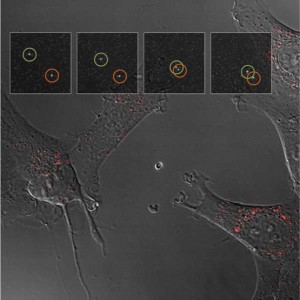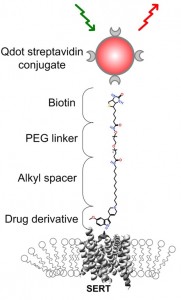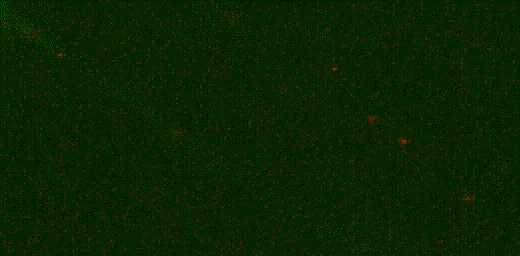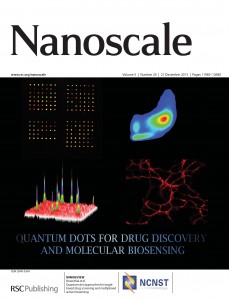
Fluorescent nanocrystals have several advantages over organic dye molecules as fluorescent markers in biology. They are incredibly bright and do not photodegrade, and they have narrow gaussian emission spectra, enabling the co-localization of several proteins simultaneously. Drug-conjugated nanocrystals attach to proteins in an extracellular fashion, enabling movies of protein trafficking. We are synthesizing drug-conjugated nanocrystals which have high affinities and selectivities for serotonin, dopamine, and norepinephrine receptor and transporter proteins. These are neurotransmitters which control critical behaviors such as mood, sleep, appetite, and aggression. With the drug-conjugated nanocrystals we are able to map the distribution of these proteins and determine mechanisms which regulate protein expression at the cell surface. These proteins are also drug targets for the serotonin selective reuptake inhibitors, atypical antipsychotics, and drugs of abuse. The drug-conjugated nanocrystals also form the basis of a high-throughput fluorescence assay for drug discovery.

The Rosenthal group has used IDT318, a homotryptamine based biotinylated probe, in conjunction with quantum dots to successfully label and track serotonin transporter (SERT) proteins within the membrane of RN46A serotonergic neurons. In addition, we made use of alexa-dye conjugated cholera toxin subunit B (CTxB) in order to demonstrate the co-localization and mobility of the serotonin transporter in relation to the lipid raft membrane domains. By tracking these two components, SERT and lipid rafts, we were able to demonstrate previously unseen mechanics and were the first to describe the mobility of single transporter proteins. Our successful use of nanocrystals targeted to cell surface proteins by high-affinity ligands establishes a paradigm that should be of broad utility in defining the single molecule behavior of drug targets.


Kovtun, O.; Sakrikar, D.; Tomlinson, I. D.; Chang, J. C.; Arzeta-Ferrer, X.; Blakely, R. D.; Rosenthal, S. J., Single-Quantum Dot Tracking Reveals Altered Membrane Dynamics of an Attention Deficit/Hyperactivity Disorder-Derived Dopamine Transporter Coding Variant. ACS Chem. Neurosci. 2015, 6 (4), 526-534.
Chang, J. C.; Rosenthal, S. J., A Bright Light to Reveal Mobility: Single Quantum Dot Tracking Reveals Membrane Dynamics and Cellular Mechanisms. J. Phys. Chem. Lett. 2013, 4 (17), 2858-2866.
Kovtun, O.; Arzeta-Ferrer, X.; Rosenthal, S. J., Quantum dot approaches for target-based drug screening and multiplexed active biosensing. Nanoscale 2013, 5 (24), 12072-12081.
Chang, J. C.; Tomlinson, I. D.; Warnement, M. R.; Ustione, A.; Carneiro, A. M. D.; Piston, D. W.; Blakely, R. D.; Rosenthal, S. J., Single molecule analysis of serotonin transporter regulation using antagonist-conjugated quantum dots reveals restricted, p38 MAPK-dependent mobilization underlying uptake activation. J. Neurosci. 2012, 32 (26), 8919-8929.
Chang, J. C.; Rosenthal, S. J., Visualization of Lipid Raft Membrane Compartmentalization in Living RN46A Neuronal Cells Using Single Quantum Dot Tracking. ACS Chem. Neurosci. 2012, 3 (10), 737-743.
Chang, J. C.; Rosenthal, S. J., Real-time quantum dot tracking of single proteins. Methods Mol. Biol. (N. Y., NY, U. S.)2011, 726 (Biomedical Nanotechnology), 51-62.
Kovtun, O.; Tomlinson, I. D.; Sakrikar, D. S.; Chang, J. C.; Blakely, R. D.; Rosenthal, S. J., Visualization of the Cocaine-Sensitive Dopamine Transporter with Ligand-Conjugated Quantum Dots. ACS Chem. Neurosci. 2011, 2 (7), 370-378.
Rosenthal, S. J.; Chang, J. C.; Kovtun, O.; McBride, J. R.; Tomlinson, I. D., Biocompatible Quantum Dots for Biological Applications. Chem. Biol. 2011, 18 (1), 10-24.


